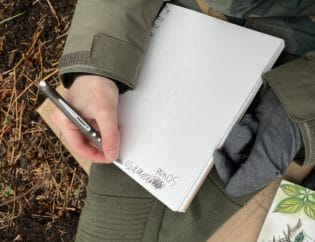
It’s the outermost layer of our planet, made of up rocks, decaying plants and animals. It seems dead but it is teeming with a hidden world of animals. In fact, it contains more living organisms than there are people on Earth.
It’s soil. And it’s vital for life on our planet. To understand why, think of it like the earth’s stomach. Busy consuming, digesting, and cycling nutrients and organisms.

https://fullcyclesoil.com/talkingaboutadirtrevolution/2017/6/11/the-inside-scoop-on-the-dirt-beneath-your-feet
We see it every day and it looks fairly uninteresting, to be honest. But it’s one of the richest habitats on earth. Five to 10 tons of animal life can live in an acre of soil. What types of life can be found in soil? Earthworms and other decomposers are busy digesting fallen leaves and dead plants. Fungi and bacteria breaking down organic matter. Mice and other critters underground are moving seeds around where they will decompose and become a part of the soil. All of these organisms are important in making up the environment we call soil and in bringing about numerous transformations that are vitally important to life.
Your child can learn about life all around us and under us with our fun and active soil sampling activity. Head out with our Soil Sampling Field Sheet together and prepare to be amazed!
Soil Survey Activity
This activity has been adapted from City Kids and City Critters from the Houston Arboretum and Nature Center. It should be done with an adult present to ensure biting/stinging insects are not disturbed.
Field Notes are important in any naturalist observation. Take along our Soil Sampling Field Observation Sheet and begin by noting the weather and the location.
Materials needed: two shoebox-sized boxes; digging tool, damp paper towel.

Step 1. Measure a 12-inch square in the ground.
Step 2. Dig! Shovel the soil into one box. This will be your sorting box.
Step 3. Shake the box a bit to help see the critters.
Step 4. Place a damp paper towel in the bottom of a second box, your critter box. Lift out any critters with a small shovel or spoon. Be careful of biting critters! Leave any that can be dangerous to you alone. For the others, carefully place them inside the critter box. Keep a lid on it bc critters are sensitive to light and can dry out. They were just underground in the damp, dark soil.

Step 5. Dump the leftover soil from the sorting box next to the hole.
Step 6. Keep digging until the soil hole is 12 inches deep.
Step 7. ID your critters using our ID sheet or your favorite source. Use the Soil Sampling Field Sheet to keep notes.
Step 8. Return the critters to the soil pile and gently push the soil pile back in the hole.
Step 9 (optional): Sample in different types of environments: next to a pond; close to a tree, wherever you see soil!
Books About Soil
A few of the links in this post are affiliate links. This means if you click on the link and purchase the item, we will receive a small affiliate commission at no extra cost to you. All opinions remain our own.














